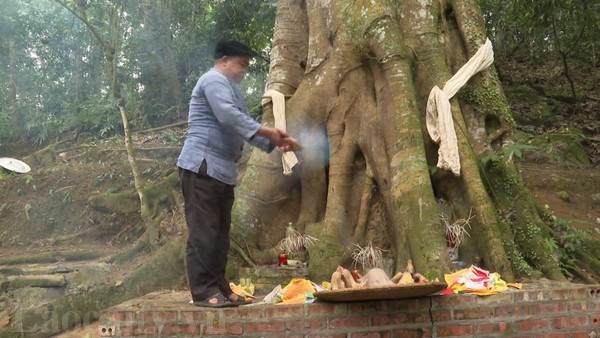Forest worship ceremony - special cultural heritage of Mong people
Apart from praying for a bumper crop and wealth, the forest worship ceremony of the Mong ethnic people in Si Ma Cai is also meant to cultivate a love for nature and the awareness of environmental protection in the community.
 A shaman performs the forest worship ceremony in Si Ma Cai district, Lao Cai province (Photo: laocaitv.vn)
A shaman performs the forest worship ceremony in Si Ma Cai district, Lao Cai province (Photo: laocaitv.vn)The Ministry of Culture, Sports and Tourism has listed the forest worship ceremony of the Mong ethnic people in Si Ma Cai district, the northern mountainous province of Lao Cai, as part of the national intangible cultural heritage.
The recognition is hoped to be a driving force for the local Mong community to continue upholding the tradition of protecting forests, water resources, and the environment.
Ly Seo Vang, Vice Secretary of the Si Ma Cai Party Committee, said people in the district are all happy that the forest worship ceremony of the Mong people has been named national intangible cultural heritage, which is a valuable title, and the district will work harder to preserve and bring into play these cultural values so as to better protect the forests.
The forest worship ceremony is a long-standing practice that has been passed down from generation to generation in the Mong community in Si Ma Cai.
It is associated with the polytheism of Vietnamese farmers throughout history. People believe that there is a forest god who protects locals and endows them with good health, peace, wealth, and happiness.
The Mong people in the district hold the forest worship ceremony in the second and sixth lunar months every year to pray for good weather, bumper crops, prosperity, and solidarity. The practice also aims to cultivate a love for nature and the awareness of environmental protection in the community.
Local patriarchs said this ceremony dates back hundreds of years, noting that it is also intended to enhance the solidarity among Mong people in different villages in border areas so as to safeguard peace and assist one another in the face of foreign invaders.
A sacred forest is called “lung san” in the Mong language.
It is said that the ceremony was first held in the era of King Tu Duc, who reigned from 1848 to 1883. At that time, local residents and two patriarchs named Giang Chan Min and Giang Chan Hung chose the forest in Lung San hamlet of Lung Than commune to hold an oath-taking ceremony, promising to join people of ethnic groups to rise up against the Co Vang enemy, which came from the area which is now Ha Giang province to rob villagers' assets.
Under the two patriarchs’ command, ethnic communities in Si Ma Cai succeeded in defeating the Co Vang enemy and winning back peace.
Cu Seo Sung, a patriarch in the district, said to commemorate Giang Chan Minh and Giang Chan Hung, local residents selected the days of the dragon in the second and sixth lunar months to pay tribute to them and pray for forest development, bumper crops, prosperity, safety, and happiness.
Tran Hoai Long, deputy head of the division for culture of Si Ma Cai district, said Pho Cu hamlet in Si Ma Cai commune and Lung San hamlet in Lung Than commune have the largest forest worship ceremonies in the district.
The biggest ancient trees are the venues for the ceremony, which consists of rituals and festive activities.
Offerings in the ceremony will be divided evenly for all participants, who will later listen to patriarchs, village leaders, and shamans disseminating local rules on forest protection.
Practiced for centuries, the forest worship ceremony of the Mong people in Si Ma Cai has contributed to the richness of the country’s traditional cultural values./.













